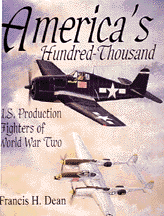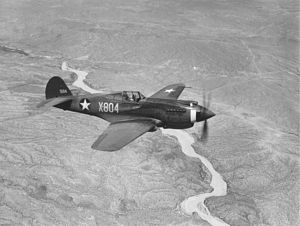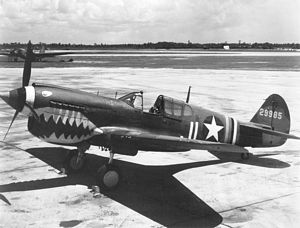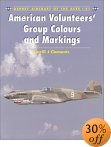Curtiss P-40 Warhawk
The Flying Tigers' plane
By Stephen Sherman, Apr. 2002. Updated January 24, 2012.
The P-40 was the workhorse of the Allied aerial arsenal right through 1944. It may not have been as "hot" as later designs, but it was a sound design, based on the earlier P-36, mated to the Allison V-1710 engine, that Curtis was able to produce in large numbers. As Clair Chennault found out in China, the P-40 was heavier, faster, and sturdier than Japanese fighters, and it out-gunned them as well. Properly handled and below 15,000 feet, it was a lethal
Colonel (later General Claire Lee Chennault) had been in China since the mid-Thirties. An outspoken advocate of "pursuit" (as fighter planes were called then), in an Army Air Force dominated by strategic bomber theorists, he alienated many of his superiors. But in China, equipped with P-40's, he developed the basic fighter tactics that American pilots would use throughout the war.
The Japanese planes used over China were much more maneuverable than his Warhawks, whose advantages were speed in a dive, superior firepower, and better ability to absorb battle damage. Chennault worked out and documented the appropriate tactics that capitalized on the relative strengths of the American fighters: intercept, make a diving pass, avoid dogfighting, and dive away when in trouble. This remained the fundamental U.S. fighter doctrine throughout the Pacific War.
Chennault's American Volunteer Group, popularly known as "The Flying Tigers" flew their P-40B's and P-40C's with great success against the Japanese aircraft.
Joel Paris was a P-40 ace with the 49th Fighter Group in the Southwest Pacific. In Fire in the Sky: The Air War in the South Pacific, he relates his opinion of the P-40:
I never felt that I was a second-class citizen in a P-40. In many ways I thought the P-40 was better than the more modern fighters. I had a hell of a lot of time in a P-40, probably close to a thousand hours. I could make it sit up and talk. It was an unforgiving airplane. It had vicious stall characteristics. ... If you knew what you were doing, you could fight a Jap on even terms, but you had to make him fight your way. He could out-turn you at slow speed. You could out-turn him at high speed. When you got into a turning fight with him, you dropped your nose down so you kept your airspeed up, you could out-turn him. At low speed he could out-roll you because of those big ailerons. They looked like barn doors on the Zero. If your speed was up over 275, you could out-roll it. His big ailerons didn't have the strength to make high speed rolls ...
You could push things, too. Because you knew one thing: If you decided to go home, you could go home. He couldn't because you could outrun him. He couldn't leave the fight because you were faster. That left you in control of the fight. Mind you: The P-40 was a fine combat airplane.
Robert DeHaven, a 14 kill ace, also with the 49th F.G., scored ten of his kills in the P-40.
The British also used the P-40, called Tomahawk and Kittyhawk, especially in the North African and Mediterranean Theatres.
P-40
Seeing many fighters using in-line, water-cooled engines to great advantage, in 1938 Curtiss-Wright decided to adapt its model P-36 Hawk to the Allison 1710, an 1160 HP engine. Designated the XP-40, the prototype was simply a P-36 with the in-line engine; it took its first flight in October, 1938. For guns, it only carried a pair of 30 caliber machine guns, not uncommon for the late 1930s, but puny as World War Two developed.
The Army promptly selected the Curtiss airplane for production, ordering 524 in 1939, the largest order for an American fighter at that time. At $13 million, each one cost $25,000 dollars.
P-40B
Even before America's entry into the war, it became evident that more powerful weaponry was called for, The Buffalo plant began to outfit the P-40B with four (wing-mounted) 30 caliber and two (nose-mounted) 40 caliber machine guns. The "B" model also introduced cockpit armor. With war looming, 107 Warhawks (P40's and P-40B's) moved up to the Philippines by December, 1941. The Japanese onslaught caught them unawares, and four days later only 22 remained. Buzz Wagner of the 17th Pursuit Squadron was one of the few Americans to achieve any success in those dark days in the Philippines. Flying a P-40, Wagner downed 5 Japanese planes before being evacuated to Australia in January 1942.
Keeping of the early P40 models, with some originally designated for Lend-Lease delivery to the British, as "Tomahawks," and other hurriedly shipped over to China for the AVG, is complicated. To this day, debates rage over the Flying Tigers version: Was it the P-40B or P40C?
P-40C
Self-sealing fuel tanks marked this variant, over 900 went to the British, for use in North Africa. The USAAC received 193. The slowest of all P-40 models, the P-40C had a top speed of only 345 MPH (some sources say 328). Over Egypt, "Tomahawk IIB" was no match for the Bf-109E and was soon relegated to ground attack.P-40D
Marked by a deeper chin radiator, the P-40D's profile visibly differed from earlier versions. Curtiss also switched the four wing-mounted guns to heavier 50 caliber types, and got rid of the nose-mounted guns - and with them the need for through-the-prop synchronization gear. With a more powerful Allison 1710-39, the P-40D could make 362 MPH in level flight.The Brits took delivery of most of the "D" models, and distinguished them from earlier "Tomahawks" with the name "Kittyhawk."
P-40E
2,320 P-40E's rolled off Curtiss production lines, mostly in 1942. Continuing the trend to bulk up, it carried six 50 caliber machine guns in the wings, ultimately the most common armament of American fighters in WW2. Two-thirds of them, designated Kittyhawk Mk IA, went to the RAF, the RCAF, the RAAF, and the RNZAF.P-40F
As the weight of the Warhawk had crept up to almost 9,000 lbs, Curtiss installed the powerful Merlin engine on the P-40 airframe. The prototype, XP-40F, achieved a top speed of 373 MPH. Inevitably, the P-40F production version weighed even more (9,870 lbs) and speed dropped off to 364 MPH.P-40K
Starting in August, 1942, Curtiss-Wright produced the "K," which incorporated Allison's latest engine, the 1710-73, capable of 1325 HP. Otherwise the "K" was similar to the "E."P-40L
This was a stripped-down version of the P-40F, dubbed the "Gypsy Rose Lee," with 2 guns, armor, and some fuel removed to save weight. These efforts only increased the speed by 4 MPH over the F model. 720 were produced.
P-40M
Allison's 1710-81 engine, rated at 1360 MPH, powered the P-40M. 600 were produced, mostly delivered to the RAF.
P-40N
The final Warhawk, the P-40N, entered production in late 1943; eventually 5,000 were built. Powered by the Allison 1710-99, the "N" could make 378 MPH, at least in the lightened-up early production blocks. But more weight was added back, and typical P-40N's topped out at 350 MPH.
| Production | Speed | Armament | Engine and Performance | Weight | Other | ||||||||||||||
|---|---|---|---|---|---|---|---|---|---|---|---|---|---|---|---|---|---|---|---|
| Variant | Svc. Del. | # Built | MPH | 8mm | 12.7/13mm | Bomb | HP | Engine(Mfr/Number) | Climb ft/min | Ceil FT | Rng Mi. | Ext Rng | Empty Wt. lb. | Loaded Wt. | Max.Wt. lb. | Crew | # Eng. | Oth Name | Modif. |
| P-40 | Jun-40 | 340 | 357 | 2 | 2 | 1,090 | Allison V-1710-33 | 3,080 | 32,570 | 800 | 5,376 | 6,787 | 7,215 | 1 | 1 | Tomahawk I | |||
| P-40B | Mar-41 | 241 | 352 | 4 | 2 | 1,090 | Allison V-1710-33 | 2,860 | 32,400 | 730 | 1,230 | 5,590 | 7,326 | 7,600 | 1 | 1 | Tomahawk IIA | ||
| P-40C | Apr-41 | 1,123 | 345 | 4 | 2 | 1,090 | Allison V-1710-33 | 2,650 | 29,496 | 730 | 945 | 5,812 | 7,459 | 8,058 | 1 | 1 | Tomahawk IIB | ||
| P-40D | May-41 | 582 | 362 | 4 | 500 | 1,150 | Allison V-1710-39 | 2,200 | 29,000 | 650 | 850 | 6,350 | 8,000 | 8,670 | 1 | 1 | Kittyhawk I | eng.+, wing guns | |
| P-40E | Sep-41 | 2,320 | 362 | 6 | 1,150 | Allison V-1710-39 | 2,100 | 29,000 | 650 | 1,400 | 6,350 | 8,280 | 9,200 | 1 | 1 | Kittyhawk IA | +2 guns | ||
| P-40F | Dec-41 | 1,560 | 364 | 6 | 1,300 | Packard V-1650-1 | 2,100 | 34,400 | 700 | 1,500 | 6,590 | 8,500 | 9,350 | 1 | 1 | Kittyhawk II | new eng. | ||
| P-40K | Aug-42 | 1,300 | 362 | 6 | 500 | 1,325 | Allison V-1710-81 | 2,300 | 38,158 | 350 | 1,600 | 6,400 | 8,400 | 10,000 | 1 | 1 | |||
| P-40L | Jan-43 | 720 | 368 | 4 | 500 | 1,300 | Packard V-1650-1 | 2,300 | 38,158 | 350 | 6,340 | 8,250 | 9,100 | 1 | 1 | Gypsy Rose Lee | stripped | ||
| P-40M | Nov-42 | 600 | 362 | 6 | 500 | 1,200 | Allison V-1710-18 | 2,300 | 38,158 | 350 | 1,600 | 6,400 | 8,400 | 10,000 | 1 | 1 | Kittyhawk III | ||
| P-40N | Mar-43 | 5,000 | 350 | 6 | 500 | 1,325 | Allison V-1710-81 | 2,120 | 31,000 | 750 | 1,080 | 6,000 | 8,350 | 11,400 | 1 | 1 | Kittyhawk IV | structure,wheels | |
 America's
Hundred Thousand, by Francis H. Dean
America's
Hundred Thousand, by Francis H. Dean
This book covers in detail the eleven U.S. fighter aircraft types planes produced just before and during World War II - with a combined production total of just over 100,000 aircraft.
Covered are the Army Lockheed P-38 Lightning, P-39 Airacobra, Curtiss P-40 Tomahawk/ Kittyhawk/ Warhawk, P-47 Thunderbolt, North American P-51 Mustang, Northrop P-61 Black Widow, and the Navy F2A - Buffalo, F4F - Wildcat, F4U - Corsair, and F6F - Hellcat fighters. The text is supplemented by more than 650 photographs, and 200 tables and graphs. Fighter production figures are also included.
After an introduction of each type, a heavily illustrated overview of earlier inter-war production from 1920-on, along with a discussion and illustration of wartime experimental types, is provided. A lengthy section considering several technical factors affecting fighter performance follows. These include engine models, supercharger types, propellers, aerodynamic thrust, lift and drag, aircraft weight, balance, stability and control, and armament.
America's Hundred Thousand also provides details of each U.S. World War II production fighter in terms of models and changes, numbers planes produced, and major engine and aircraft performance aspects - in tabular and graphical form - details of weights, discussion of handling qualities and general comments, along with detailed descriptions containing many illustrations of aircraft structures and systems showing the technology of that time. In addition a comprehensive week-to-week and month-to-month chronology of development and wartime combat operational life for each fighter is provided, including many photos. This study concludes with comparisons of the eleven types in terms of program milestones, aircraft drag, power available at various altitudes, speed, climb, rolling and turning, acceleration, and diving performance, as well as general evaluations by World War II pilots.



